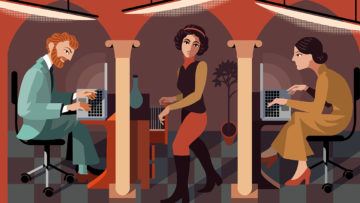Catherine Nixy in 1843 Magazine:
 Over the past year many of us have sat at home, confined to the same four walls for much of the day, contemplating the same view, munching the same lunch and wearing the same clothes (at least below waist level). While the key workers of the world actually kept everything running by going out to work, many of us have likened our privileged isolation to that of a monk confined in a monastery, world at bay. The word “monk” comes from a Greek word meaning “alone”, which is exactly how monks spent their earliest days, living and working anywhere from the sands of the Syrian desert to the banks of the River Nile. One particularly celebrated figure spent almost 40 years standing on a pillar in Syria until his feet exploded and his spine collapsed. (Those missing their ergonomic office chairs may sympathise.)
Over the past year many of us have sat at home, confined to the same four walls for much of the day, contemplating the same view, munching the same lunch and wearing the same clothes (at least below waist level). While the key workers of the world actually kept everything running by going out to work, many of us have likened our privileged isolation to that of a monk confined in a monastery, world at bay. The word “monk” comes from a Greek word meaning “alone”, which is exactly how monks spent their earliest days, living and working anywhere from the sands of the Syrian desert to the banks of the River Nile. One particularly celebrated figure spent almost 40 years standing on a pillar in Syria until his feet exploded and his spine collapsed. (Those missing their ergonomic office chairs may sympathise.)
From the fourth century onwards, the great monkish wfh experiment fell out of fashion and monks flooded into monasteries – just as many employers hope their staff will do this summer, as life reverts to some semblance of its before-covid (bc) self.
A monastic life may sound surprisingly familiar. They put on drab work clothes each day to turn up for duty, same time, same place. They embraced the nine to five (or, to be precise, the 6am to 7pm. Tough boss). If going back to the office reminds you how annoying your colleagues are, spare a thought for the monks who had the same ones – and endured their same noxious habits – until the day they died (and, assuming they’d laid their bet in Pascal’s wager correctly, after it, too). If you hated the way your tablemate slurped his soup or sang evensong, you simply had to keep quiet and offer up your suffering to God.
Once monks gave up their flexi-work freedoms they had to find a way to get along with their brethren. Judging by the outpouring of literature spawned by this move, as soon as corporate monkish life began, brothers started to annoy each other.
More here.
